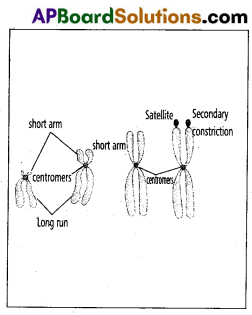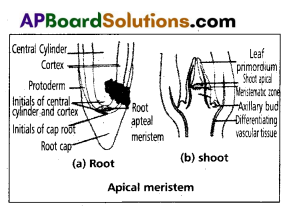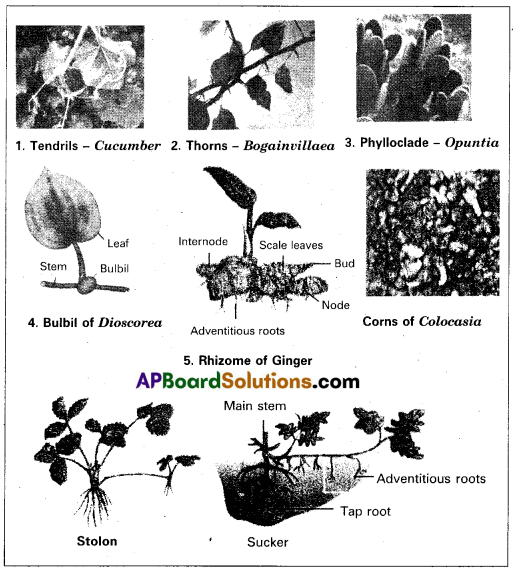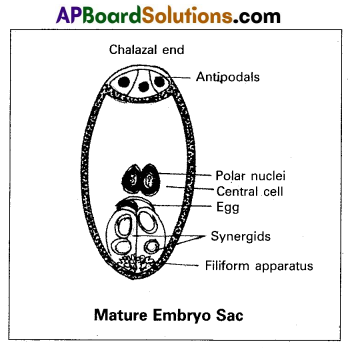Successful navigation through TS Inter 1st Year Botany Model Papers and TS Inter 1st Year Botany Question Paper March 2016 builds students’ confidence in their exam-taking abilities.
TS Inter 1st Year Botany Question Paper March 2016
Time: 3 Hours
Maximum Marks: 60
General Instructions:
Note : Read the following instructions carefully.
- Answer all questions of Section ‘A’. Answer any six questions out of eight in Section ‘B’ and answer any two questions out of three in Section – ‘C’.
- In Section ‘A’, questions from Sr. Nos. 1 to 10 are of “Very Short Answer Type”. Each question carries two marks. Every answer may be limited to five lines. Answer all the questions at one place in the same order.
- In Section ‘B’, questions from Sr. Nos. 11 to 18 are of “Short Answer Type”. Each question carries four marks. Every answer may be limited to 20 lines.
- In Section ‘C’, questions from Sr. Nos. 19 to 21 are of “Long Answer Type”. Each question carries eight marks. Every answer may be limited to 60 lines.
- Draw labelled diagrams wherever necessary for questions in Section ‘B’ and C.
Section – A (10 × 2 = 20)
Note : Answer all questions. Each answer may be limited to 5 lines.
Question 1.
Who is popularly known as father of Botany ? What was the book written by him ?
Answer:
“Theophrastus” is regarded as the father of Botany. He wrote a book “de Historia plantarum”.
Question 2.
Define the terms, couplet and lead in taxonomic key.
Answer:
The contrasting characters occur in a pair is called ‘couplet’. Each statement in the key is called lead’.
Question 3.
State two economically important uses of heterotrophic bacteria.
Answer:
Heterotrophic bacteria help in making curd from milk, production of antibiotics and also help in nitrogen fixation in legume roots.
![]()
Question 4.
Which part of the flower in cashew plant forms the false fruit ?
Answer:
The pedicel develops into false fruit in cashew plant.
Question 5.
Define mericarp. In which plant you find it ?
Answer:
The Schicarpic fruit splits into one seeded bits called mericarps. These are seen in Acacia.
Question 6.
Give the technical description of anthers of Allium cepa.
Answer:
In Allium cepa, the anthers are dithecous, basifixed, introrse and dehisce longitudinally.
Question 7.
Give one example for each of amino acids, sugars, nucleotides and fatty acids.
Answer:
Amino acids : Glycine, alanine
Sugars : Glucose, ribose.
Nucleotides : Adenylic acid.
Fatty acids : Glycerol, Lecithin.
Question 8.
What is middle lamella made of ? What is its functional significance ?
Answer:
Middle lamella is made up of calcium pectate and magnesium pectate. It holds or glues the different neighbouring cells.
Question 9.
Which of the four chromatids of a bivalent at prophase -1 of meiosis can involve in cross over ?
Answer:
Crossing over occurs between non-sister chromatids of the homologous chromosomes.
![]()
Question 10.
Define heliophytes and sciophytes.
Answer:
Plants grow in direct sunlight are called Heliophytes. Plants grow in in shady places are called Sciophytes.
Section – B (6 × 4 = 24)
Note : Answer any six questions. Each answer may be limited to 20 lines.
Question 11.
Write a note on economic importance of Algae and Bryophytes.
Answer:
Economic importance of Algae :
- A half of the carbon dioxide fixation is carried out by Algae through photosynthesis and increases the level of oxygen in the environment.
- Many sps. Of Porphyra, Laminaria and Sargassum are used as food.
- Some marine Brown algae and red algae produce large amounts of hydrocolloids like Algin and Carrageen.
- Agar – Agar, a commercial product obtained from Gelidium and Gracilaria is used to grow microbes and also in the preparation of ice-creams and gellies.
- Iodine is extracted from Laminaria.
- Chlorella and Spirulina are used as food supplements even by space travelers.
Economic importance of Bryophytes :
- Some mosses provide food for herbaceous mammals, birds and other animals.
- Species of Sphagnum. A moss provide peat used as fuel and because of its capacity to hold water as packing material for trans-shipment of living material.
- Mosses along with lichens are the first organisms to colonise rocks.
- Mosses form dense mats on the soil, thus prevents soil erosion.
- They play a significant role in plant succession.
Question 12.
Give a brief account of dinoflagellates.
Answer:
- They are mostly marine and photosynthetic. They appear yellow, green, blue or red depending on the pigments in their cells.
- The cell wall has stiff cellulose plates on the outer surface.
- They have two flagella and produce spinning movements. So these protists are called ‘Whirling whips’.
- The nucleus has condensed chromosomes which are without histones.
- Red dinoflagellates like Gonyaulax undergo rapid multiplication and make the sea appear red. (Red tides of Mediterranean Sea).
- Toxins produced by them may kill fishes.
Question 13.
Write a brief account on gametogenesis with examples.
Answer:
The process of formation of male and female gametes is called Gametogenesis. In some Algae, the two gametes are similar in appearance. They are called Homogametes (isogametes).e.g: Cladophora. In majority of sexually reproducing organisms, the two gametes formed are morphologically different. They are called Heterogametes. The male gamete is called antherozoid – and the female gamete is called the egg. e.g: Funaria and Pteris.
![]()
Question 14.
Describe the nonessential floral parts of plants belonging to Fabaceae.
Answer:
In Fabaceae, the nonessential floral parts are Calyx and Corolla.
Calyx: Sepals 5, gamosepalous, valvate aestivation and odd sepal is anterior.
Corolla : polypetalous, papilionaceous type consisting of large posterior petal called standard petal, two lateral petals called wings and the two anterior fused petals are called keel petals which enclose essential organs. They show descendingly imbricate aestivation.
Question 15.
Give a brief account of the types of chromosomes based on the position of centromere.
Answer:
Basing on the position of the centromere, four types of chromosomes are recognized.
They are
- Metacentric : Centromere is present in between the two arms of the chromosome. It is ‘V’ shaped and consists of two equal arms.
- Sub-Metacentric : Centromere is present slightly away from the midpoint of a chromosome. It is ‘L’ shaped and consists of two unequal arms.
- Acrocentric : Centromere is present at the sub terminal position of the chromosome. It appears ‘J’ shaped and consists of one long arm and one short arm.
- Telocentric : Centromere is present at the terminal position of the chromosome. It appears T shaped and consists of the one arm.

Question 16.
Describe the cell organelle which contains chlorophyll pigments.
Answer:

The cell organelle, certains the chlorophyll pigments is chlorplast.
They are found in pesophyll cells of leaves adn are oval or spherical or discoid or in ribbon shape. They are 5 – 10mm in length and 2 – 4 mm in width.
Each chloroplast is double membrane bound cell organelle which encloses clouless amorphous stroma.
A number of organised, flattened membranous sacs are present in stroma, which are aranged like in stacks (pile of coins) called grana Thylacoids. These are connected by flat membranous tubules called stroma lamellae. The strome contains enzymes necessary for the synthesis of proteins, small DNA molecules and 70’s’ type of ribosomes. The Thylakids consists of pigments necessary for light reaction (ie) chlorophyll ‘a’, ‘b’, caroteres and xanthophylls.
Question 17.
State the location and function of the different types of meristems.
Answer:

Based on the position, meristems are classified into three types.
They are
- Apical meristems : The meristems that are present at the tip of the stem and at the tip of the . root are called apical meristems. They help in linear growth of the plant body.
- Intercalary meristems : The meristems that are present in between mature tissues are known as intercalary meristems. They contribute to the formation of the primary plant body and also involves in internodal length.
- Lateral meristems : The meristems that occur in the mature regions of roots and shoots peripherally called lateral meristems. They help in increase in thickness of the plant organs.
e.g : vascular cambium and cork cambium.
![]()
Question 18.
Write a brief account on the classification of xerophytes.
Answer:
Xerophytes are classified into three types based on the
morphology, physiologyand life cycle pattern.
They are :
1. Ephemerals : The plants which complete their life cycle within 6 – 8 weeks are called ephemerals. They are also called drought evaders or drought escapers. E.g : Tribulus.
2. Succulents : These plants absorb large amounts of water during rainy season and store it in different parts in the form of mucilage and become fleshy or succulent. The stored water is sparingly utilized during dry periods. These plants are also called drought avoiding plants.
E.g : a. Stem succulents : Opuntia,
b. Leaf succulents : Bryophyllum, Agave.
c. Root succulents : Asparagus.
3. Non-succulents : They are also called true xerophytes. These are perennial plants which can withstand prolonged drought periods, e.g: Casuarina, Nerium.
Section – C (2 × 8 = 16)
Note : Answer any two questions. Each answer may be limited to 60 lines.
Question 19.
Explain how stem is modified variously to perform different functions (write any 6 modifications)
Answer:
Stems are modified in several ways to perform different functions.
They are :
1) Tendrils : Slender, spirally coiled structures which may develop either from auxiliary bud (cucumber) or from terminal bud (grapes) are called tendrils. They help in climbing.
2) Thorns : Buds are modified into woody, straight pointed thorns which protect plants from grazing animals.
Ex : Citrus, Bougain villaea.
3) Phylloclade : In some plants of acid zones, leaves are modified into scales or spines to reduce the rate of transpiration. In such plants, stems are modified into flattened, green structure which carryout photosynthesis. Such stems are called phylloclades.
Ex : In euphorbia stem is cylindrical, in casuarina needle like, and in opuntia – flattened, fleshy green.
4) Bulbils : In some plants, the vegetative buds or floral buds store food materials. At maturity, may detach from the parent plants, develop.adventitious roots, grow as new plants thus help in vegetative reproduction. Ex : Diascoria.

5) Underground stems : In some plants, stem grows into soil, store food materials, show perennation, to resist unfavourable conditions and also help in vegetative reproduction. Such stems are called underground stems.
Ex : Rhizome – Ginger, com – colacacia.
6) Sub aerial stems : In some plants, some part of the stem is underground and some part is aerial. Such stems are called sub aerial stems. In such plants, slender, lateral branches arises from the base of the main axis, grow vertically, arches downwards, produce adventitious roots when touches the ground. When they separates from the parent plant, they develop into new plants they help in vegetative reproduction.
Ex : Stolons – Nerium, Jasmine
Suckers – Chrysanthemum, Mertha.
Question 20.
With a neat labelled diagram describe the parts of a mature embryo sac. Mention the role of synergids.
Answer:
Mature angiosperm embryosac shows three parts.
They are
1) Egg apparatus
2) Antipodals
3) Central cell

1) Egg Apparatus: Three cells present towards the micropyle of the embryosac together called egg apparatus. Of which, the central, largest one is called egg and two lateral cells are called synergids. Synergids show finger like projections towards the micropyle called filliform apparatus.
2) Antipodals : Three cells present towards the chalazal end of the ovule are called antipodals. They are also referred to as vegetative cells of the embryosac and disintegrates before or after fertilisation.
3) Central cell : It is the largest cell of the embryosac. It is formed by the fusion of two polar nuclei. It is also called secondary nucleus. It shows central vacuole and 2 haploid polarnuclei.
Role of synergies :
- The filliform apparatus of the synergids absorbs foo materials from the Nu cells and supplies to embryosac.
- It also secretes some chemicals which direct the growth of the pollen tube towards embryosac.
![]()
Question 21.
Describe the internal structure of a Dicot root.
Answer:
A thin transverse section of dicot root shows three parts namely
(i) Epidermis
(ii) Cortex and
(iii) Stele.
(i) Epidermis – It is the outer most layers made of thin walled cells. Some cells protrude in the form of unicellular root hairs. So called Epiblema. It protects the inner parts. Root hairs help in absorption of water from the soil.
(ii) Cortex – It consists of several layers of thin walled parenchyma cells with inter cellular spaces. The Innermost layer of cortex is called Endodermis. It comprises a single layer of barrel shaped cells without Intercellular spaces. The tangential as well as the radial walls of Endoderm cells show suberin thickenings called casparian strips. Some cells opposite to protoxylem lack these strips called passage cells. They help in the movement of water and dissolved salts from cortex into xylem.
(iii) Stele : It is the central part, consists of 4 layers.

(a) Pericycle : It is single layered, made of thin walled parenchyma cells, present next to endodermis. It produces lateral roots and become vascular cambium during secondary growth.
(b) Vascular Bundle : Xylem and phloem constitutes vascular Bundle. They are arranged on different radius (in alternate manner) so called Radial vascular Bundle, Xylem is exarch, where protoxylem is towards periphery and metaxylem is towards the center. Xylem is diarch to tetrarch condition. Xylem helps in conduction of water and minerals and phloem helps in conduction of food materials.
(c) Medulla : It is absent or small, made of parenchyma cells. When present, it helps in the storage of food and water.
(D) Conjunctive tissue : The parenchyma present between xylem and phloem is called conjunctive tissue which also involves in secondary growth.